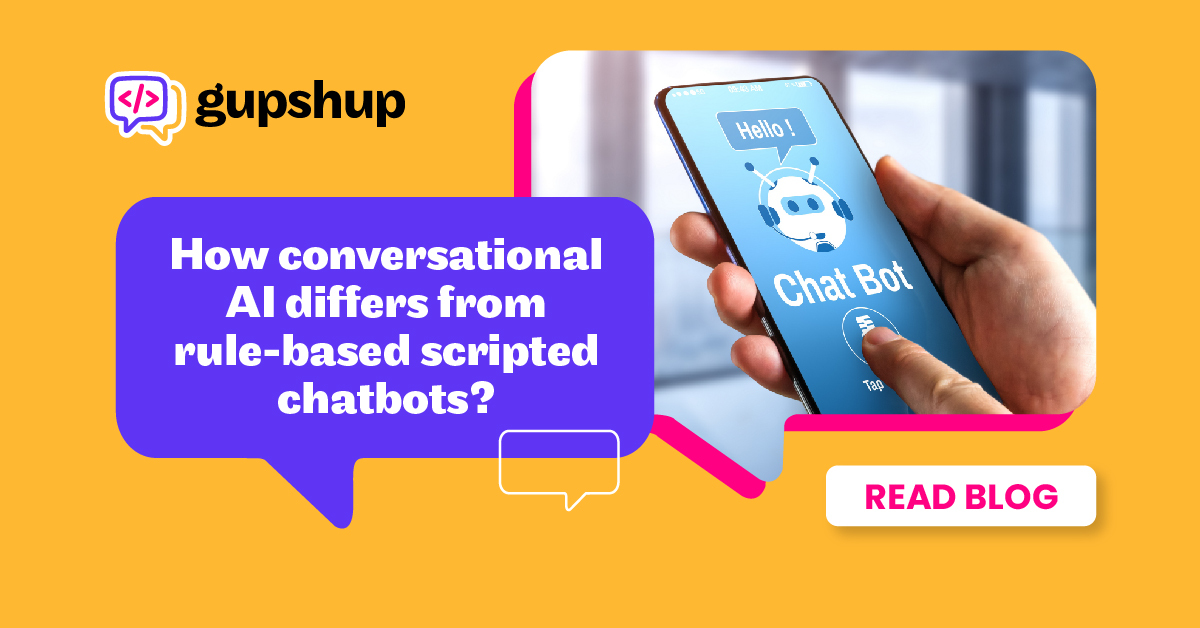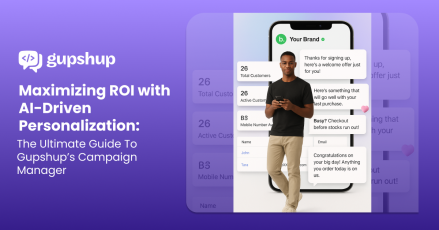How conversational AI differs from rule-based scripted chatbots

With every website that you visit, it might seem like every company is getting into the chatbot business. Facebook, Google, and Amazon, Ebay all have a bot or two to offer. They want people to believe that AI will be the next big thing in technology – but they may be wrong about that.
Conversational AI might be new, but rule-based and scripted chatbots have been around for some time.
So, what’s the difference between conversational bots and scripted ones?
Conversational bots interact with humans on a personal level by mimicking natural human speech patterns. These can include tone of voice, predicting what comes next, or even giving suggestions that users might not have thought of. Such functionalities make them engaging for customers who are looking for more than just information from bots.
This blog will cover what conversational AI means and how it differs from rule-based or scripted chatbots. We’ll also look at why companies use conversational bots and the benefits of using a conversational chatbot instead of a rule-based or scripted chatbot. Let’s dive in.
The difference between an AI that is conversational and one that is rule-based or scripted
Conversational artificial intelligence is a form of artificial intelligence that allows bots to mimic natural language patterns and gestures.
Rule-based chatbots work by using a set of rules to respond to questions but have limited responses. They only cover a small group of known cases. A scripted chatbot uses a fixed script to react to user input, making it difficult for users to get non-standard answers.
Conversational chatbots are different because they allow chatbots to understand complex questions and provide accurate responses based on machine learning algorithms.

Image Source: Landbot.io
Companies use these algorithms to process user input, identify concepts in the input and find data sources that contain information related to the user input. They also help to figure out what output is relevant to provide a response to the question. Then, it will respond with the relevant information.
Having a conversational system makes it possible for bots to engage users in human-like conversations that can mimic natural language patterns, such as asking follow-up questions or providing additional details about an answer when needed.
Nowadays, we are using AI in ways we do not even know and this type of intelligence is helping the way we communicate with one another. For example, if you were checking into a hotel and told the bot that you were traveling with five people, the bot could ask which type of room you’d like to book and if any of the people had any special room requirements. That would be a more natural conversation than just saying, “No” or “Yes” to a booking query.
Why do companies want to use this type of artificial intelligence?
Companies have been wanting to use this type of intelligence for quite some time now – however, this just wasn’t possible.
The first recorded chatbot was created in the 1960s and its creator called it ELIZA. These chatbots used a pattern-matching technique to identify inputs and responses. They looked for keywords in the input sentence, such as “I want” or “I need,” which would tell the bot that the user wanted something.
As times evolved (sometime in 2009), companies started to implement more AI into their chatbots to make it possible for bots to understand and learn from user input. This is how we arrived at AI that can have a conversation: a more advanced form of a chatbot, using machine learning algorithms and artificial intelligence. These enhancements meant that companies could build better chatbots without having to use predefined scripts or rules, making it easier for the bot to understand what the user was looking for.
Conversational AI is used in healthcare to support nurses, doctors, and other care providers. Healthcare companies use these chatbots to answer questions that patients have about their appointments or medications.
This type of intelligence is becoming increasingly common in the travel industry too, where chatbots can answer questions about flight times, commercial liability, hotel accommodations, and car rentals.
This is all beneficial for customer service because it allows companies to answer questions in a more friendly manner. As a branding tool, AI will enable companies to provide a personalized experience without any human interaction needed. It also allows companies to deal with more requests and questions, making it easier for customers to get an answer without waiting in line or talking to a representative.
As conversational AI continues to evolve, there are several reasons why companies want to use the combination of AI and natural language processing (NLP) in their chatbots.
Create a conversational bot that will be successful with customers
It’s a fact that having a scripted chatbot at any point in a company’s lifecycle will not provide a good customer service experience. To avoid this, companies have to create a bot that can understand and learn from what the user is saying through natural language processing (NLP) or machine learning algorithms.
If you’re planning on using AI to develop your chatbot for business, it’s essential to make sure you use AI and NLP appropriately. NLP allows the chatbot to search for keywords within an input sentence. The more complex the keywords themselves are, the more complicated it will be for the bot to respond accordingly. Which means that if you want people to get information quickly, then you must keep questions simple and easy to understand.
Remember that when you’re developing a new chatbot, it will be using NLP as a way of learning. That means the bot needs to collect data to understand what the user is asking for. If your bot doesn’t have enough information about a subject, it won’t answer questions appropriately, and you’ll get bad reviews from customers who aren’t happy with your customer service experience.
For example, if you are developing an AI writing software bot, it must have data that is not only about the subject you want but also specific to how people write specific texts and keywords used. Writing is a vast topic, and therefore if you want your bot to understand all the possible questions, it has to have an extensive knowledge database for it to answer questions correctly.
The importance of understanding how people talk
To make your bot more human-like and engaging for customers, it’s important to have a deep understanding of how people talk. That means you should know the common questions and sentences that people ask when they need help from your company.
To better understand how users talk, companies can do several things:
- They can analyze customer service interactions in a texting interface or online chat box to determine what works well and what doesn’t work well for their customers. For example, the top real estate chatbots help brokerage firms save time and cost when handling customer queries and complaints. These chatbots have been trained to study past conversations and behaviors using AI and predictive analytics.
- If you use a chatbot on your website, it’s important to have some sort of customer service team behind the bot to help out customers with questions or problems. This is especially the case as the bot learns and improves.
- When creating your chatbot, you should always put yourself in the customer’s shoes. If you’re not asking questions relevant to who your customers are, they will move on to another bot or company that can give them what they want.
Keeping the above points in mind, it’s essential to take your time and do your research to get more accurate data. Not taking enough time for this stage of development could result in you providing a negative experience to customers who ultimately just want an answer to a problem they’re experiencing.
The future of conversational AI
Training conversational agents seems to be one of the major areas in which companies are currently investing. The future will likely include more human-like chatbots, ones where you can shift between topics, and bots that allow for easier conversation flow.

Image Source: Deloitte.com
It’s reasonable to assume that we’ll also eventually see chatbots in other applications. For instance, there may be a chatbot built into the leading online course platforms to facilitate a discussion about the course topics with students directly.
This means that companies will spend less time creating rules and processes for their bots and instead focus on areas that are more relevant to the company. As chatbots become widespread, it’s expected that they will focus more on the user’s individual needs to understand what they must provide them with for an optimal customer service experience.
The future is likely going towards this type of idea, one where bots can understand user needs based on words or sentences without having too many rules or processes involved when training it for certain tasks. This is good news if you currently sell products or services through a sales funnel. Using conversational chatbots can help you better engage with your customers and help them better understand what features or benefits you offer that they might want. This will also allow you to provide specific information instead of giving potential customers information that they don’t care about.
Conclusion
In conclusion, there are many ways that companies can use conversational AI to better engage with their customers and help them solve problems. Company owners and marketers need to understand the difference between conversational and rule-based chatbots because it will allow them to make better decisions about how they want their chatbots to work for them.
By taking the time to understand this technology and what it can do, you can use it to engage your clientele better and provide them with superior customer service. If you’d like to learn more about chatbots and how you can benefit from them in your business, connect with our experts for more information.
#LetsGupshup
Here are some insightful resources on conversational AI and its impact on customer engagement:




